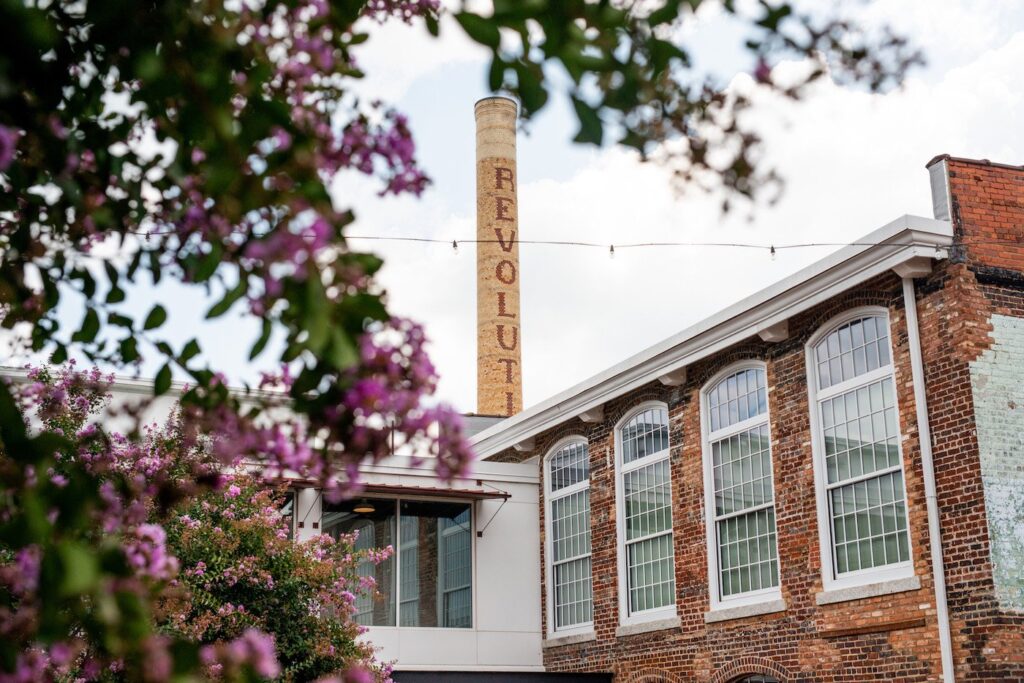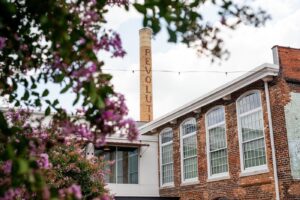The World’s Largest Flannel Mill Sat Vacant for A long time. A CDFI Gave It New Life.

That is your first of three free tales this month. Turn into a free or sustaining member to learn limitless articles, webinars and ebooks.
With enormous pink brick smokestacks that jut within the sky, Revolution Mill is tough to overlook. The 800,000-square-foot former flannel mill was one of many dozens of business mills in Greensboro, North Carolina.
When absolutely working, the mill was a cornerstone of the native economic system. It modified the lives of hundreds of residents, offering constant work for many years and completely shaping the panorama. The Cone Mill Company, which owned Revolution Mill, constructed worker housing within the surrounding hills. At this time, the straightforward one-story “mill homes” dot northeast Greensboro.
However in 1984, with demand for flannel plummeting, the mill ceased operations. For almost twenty years, it sat in disrepair.
Durham-based Self-Assist Credit score Union started because the lender to the property’s developer. Their function was to seek out cash to assist the challenge—not take the lead on it. However in 2008, the Nice Recession threw a wrench within the challenge and halted additional progress.
Self-Assist started strolling their purchasers via foreclosures — however as an alternative of going forward with the method, Self-Assist determined to develop the property themselves. By 2012, the historic property formally belonged to the credit score union. With the textile trade gone, Self-Assist determined to revive Revolution Mill and give it a brand new life as industrial and retail area, finally including a housing element with industrial loft-style residences.

A view of the Revolution Mill campus. (Picture by Self-Assist/Joey Seawell)
Taking over a 50-acre property amidst an actual property disaster can be an enormous threat for many banks. However Self-Assist isn’t a typical banking operation. As a group improvement monetary establishment, its major purpose isn’t to line its buyers’ pockets. Their stakeholders are rooted within the native communities they serve, like Greensboro. That implies that of their capability as property buyers, actual property builders, builders, and challenge collaborators, all the things they do has to make each financial and cultural sense for the group.
Loads made sense to them concerning the property, regardless of its dimension. There’s nonetheless right now a technology of residents who keep in mind working at Revolution Mill. The property was as soon as the largest flannel mill on the earth, in keeping with UNC Greensboro researchers. It additionally helped that Self-Assist Founder Martin Eakes was born and raised within the metropolis, and that the financial institution had simply accomplished its downtown nonprofit heart simply two miles from the location. The best way Self-Assist’s leaders noticed it, it might have been a waste of historic, cultural, industrial, and residential area if Self-Assist didn’t step in.
Emma Haney, the present director of enterprise and challenge administration for Self-Assist, was simply an intern within the early days of Revolution Mill. “It’s actually due to our function as a lender, and since we additionally had this capability as a group actual property developer to sort of step in and tackle such a big challenge and an advanced, credit score funding construction that we take into account doing,” she mentioned.
There are greater than 140 companies and nonprofits now working within the constructing together with eating places, cafes, artwork galleries, and occasion areas, in keeping with Haney. In the summertime of 2024, a free metropolis trolley that runs immediately from the property to downtown Greensboro made Revolution Mill much more accessible to the general public.
“It’s gigantic simply when it comes to the influence of area that was sitting there vacant earlier than, however is now energetic ultimately and bringing individuals to [the mill],” mentioned Haney. “You possibly can depend the people who dwell there, and you may depend the companies that dwell there, and people are the individuals day in and time out on campus.”

Self-Assist made deliberate selections to protect the historic structure of the previous textile mill, together with retaining the unique maple flooring—patching areas solely the place it was essential. (Picture by Marielle Argueza)
Self-Assist’s distinctive place as a CDFI gave its workforce a deep understanding of what funds have been out there to maintain creating the property as a industrial area—and finally a residential challenge too. As a result of the property was recorded on the Nationwide Register of Historic Locations in 1984, Self-Assist had entry to historic tax credit. However additionally they tapped into new market tax credit, out there to CDFI to assist develop economically “depressed” areas, and even some metropolis funding to assist restore and renew the property.
Entry to this numerous pool of funds meant decrease development prices, which finally meant permitting them to assume past the unique challenge and herald some new collaborators.
For instance, historic tax credit which reward builders for retaining nearly all of vital historic parts of the constructing, like the unique brickwork, maple flooring, and the long-lasting towering smoke stacks—allowed Self-Assist so as to add an inexpensive housing component. In the mean time, they’ve 184 models, 20% of that are inexpensive housing. “On this a part of city, that’s a whole lot of housing,” mentioned Haney.

Residents who dwell within the industrial-loft model residences have easy accessibility to the industrial and retail areas of Revolution Mill via the a number of of the mills walkways, accessible on the second story. (Picture by Marielle Argueza)
Establishments like the town and native universities have been funders and collaborators too. Greensboro’s Parks and Recreation Division helped deliver federal Greenway Funding. These funds introduced a brand new recreation path and helped restore the North Buffalo Creek that runs via the property.
UNC Greensboro was important in preserving and unearthing the historical past of the mill. Curated by UNCG researchers, small historical past reveals might be noticed alongside a number of the corridors of the property, and a everlasting historical past museum memorializes the cultural and financial influence of the previous mill in pictures and outdated equipment.
“The extra you zoom out, the extra you see simply kind of like tens of hundreds of individuals with the ability to work together with this campus that actually wouldn’t have ever been in a position to with out redevelopment,” Haney says.
This story is a part of our collection, CDFI Futures, which explores the group improvement finance trade via the lenses of fairness, public coverage and inclusive group improvement. The collection is generously supported by Companions for the Frequent Good. Join PCG’s CapNexus publication at capnexus.org.







